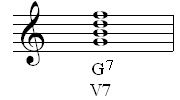Chords and Scales Combined to Make a System
a.k.a– The Major Diatonic Harmonic Systems
First some definitions:
Harmonic system for our purposes means the notes that make up a scale.
Diatonic – means progressing or sequence (belongs to), in our case the progression of notes in a major scale. We will use the short version and assume diatonic in our discussions.
Chords are Created with the Scale Notes
Simple things to remember when you develop chords associated with the scale of your choice and form a major harmonic system.
- Use a major scale
- Create chords that are made up of 3rds and 5ths
- Use only the notes of the scale to make your chord
- The chords on your system will be on lines or on spaces for root position
As an example we’ll use the C scale to create a system of chords

The staff below shows all the chords for the C major scale.

Let’s review the staff and see:
-
the pattern of lines and spaces alternate
-
that the notes used are in the scale and
-
that when you spell some of the chords some are major and some are minor and one is diminished.
Chords are Major, Minor, and Diminished
Here are the chord names and spellings for the C major harmonic system
D minor D – F – A
E minor E – G – B
F major F – A – C
G major G – B – D
A minor A – C – E
B dim B – D – F
Look at the chord names. There are 3 major chords, 3 minor chords, and one diminished chord. This is the major harmonic system.
This is true for the chords for all major scales and they will be in the same position.
The concept of position and chord type the application of numeral names to the chords can help further refine patterns for chords and scales.
Roman Numerals for Chord Position and Function
One of the methods used to identify chords is with the use of roman numerals. It can be used to identify the chord position and function within any scale.
The use of the numbers allows you to identify the chord and its use or function (major or minor) if you are in the key of C or the key of F or any other key.
The following definitions are used for the roman numerals:
-
Capitol Numerals – I, II, III IV, V, VI, VII – indicate major chords.
-
Small (lower case) Numerals – i, ii, iii, iv, v, vi, vii – indicate minor chords
-
The use of symbols will modify these two types of chords to make them diminished or augmented – º (degree symbol) for diminished and the ‘+’ (plus sign) for augmented.
The major harmonic system can be defined for any major scale with the roman Numerals.

The I, IV, and V were used for the major chords and the ii, iii, vi for the minor chords and the viiº was used for the diminished chord.
Also labeled are the I chord as Tonic, the beginning or root, and the V chord as dominant. These two are the most recognized or used chords in the system.
The Dominant Chord and the Dominant Seventh
Above we talked about the dominant V chord. In practice this chord is made into a dominant seventh chord with the addition of another minor 3rd or what is the minor 7th interval.
This chord for the C system is G7 as shown in this graphic.

When the dominant chord is played it drives music back to the tonic. You can try this for yourself on a keyboard and play this G7 and the C chord respectively. You will hear and feel the pull from V7 to I.
What this means is that in the major diatonic harmonic system you will use the V7 chord. The C major harmonic system will now look like this pict.

Major Diatonic Harmonic System Summary
- The chords developed for this system are created from the scale notes.
-
There are seven chords in the major harmonic system, 3 major chords, 3 minor chords and one diminished chord.
-
The fifth chord is a dominant chord and is usually played as a dominant 7 chord.
- The use of roman numerals can give position and function which can be used to analyze the use of the chords in any song with the major key signature.
Knowing your scales and key signatures you can create any major harmonic system.
Learning Resources
 Before you buy another music learning book you’d better read this!
Before you buy another music learning book you’d better read this!
Every wondered why musicians can work with songs so quickly? It’s all about the chords and the scales.
Learning to create, recognize and work with chords and scales is essential in mastering music.
It can be intimidating for the beginning student.
Don’t let them get the best of you. These Getting It Down Cold Workshops easily lead you through the process step by step.
And in a fraction of the time that most students take to learn this vital part of music.
Learn More Here About: Creating Chords

